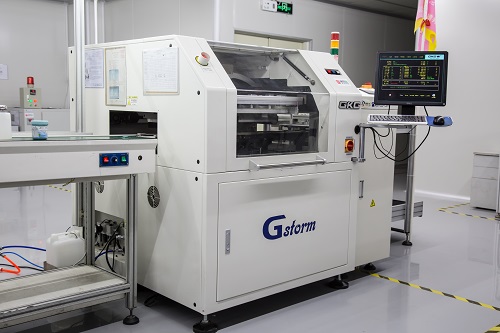About us
FASTPCBA Co.,Ltd
-
 Building 1, Senyang Electronic Technology Park, Guangming High-tech Park, Yutang Street, Guangming District, Shenzhen City.
Building 1, Senyang Electronic Technology Park, Guangming High-tech Park, Yutang Street, Guangming District, Shenzhen City.
-
 F:86-13418481618
F:86-13418481618
-
 pcba13@fastpcba.cn
pcba13@fastpcba.cn
 date:2019-05-04 09:28:00
date:2019-05-04 09:28:00
SMT circuit board assembly ink characteristics and precautions for usage
In smt circuit board assembly and manufacturing process, the place where the solder mask and the text are printed needs to be printed with ink to meet the functional requirements of the circuit board. Below we will first introduce the brands of commonly used inks. The best inks are Sun brand inks, followed is Guangxin inks, which are currently the most widely used inks on the market, as well as South Asia, Rongda, and Hanqiao inks. FASTPCBA mainly do proofing and small and medium-sized fast circuit board, the quality requirements are relatively high, the default ink is solar ink.

Circuit board ink, also called (PCB ink), refers to the exclusive ink used in printed circuit boards, with its special physical properties, such as: ink viscosity, thixotropy and fineness. Knowing these physical properties can improve the ability to use inks. When used, the best printing results can be achieved.
I have just briefly described the physical properties of the ink, So let's talk a little bit more about what’s these properties functions. The first is viscosity and thixotropy. In smt circuit board assembly process, in order to obtain the fidelity of image reproduction, the ink must have good adhesion and suitable thixotropy.
So what is the viscosity? It is the internal friction of the liquid. Under the action of external force, one layer of liquid can slide on the other layer of liquid, and the friction of the inner layer of liquid can be applied. This should be especially pointed out that temperature has a significant effect on viscosity. For example, the sliding of the inner layer of thick liquid encounters a large mechanical resistance, and the leaner liquid has less resistance.
What is thixotropy? Thixotropy is actually a physical property of a liquid. When it is stirred, the viscosity will drop. After standing, it will quickly return to its original viscosity. By stirring, the effect of thixotropy lasts for a long time, enough to reconstitute its internal structure. To achieve high quality screen printing, the thixotropy of the ink is very important.
Especially during the squeegee process, the ink is stirred to make it liquid. This action accelerates the speed of the ink through the mesh and promotes the uniform separation of the ink from the original screen. Once the squeegee stops moving, the ink returns to a standstill and its viscosity quickly returns to the original required data. Therefore, if it is a manual operation, the technical experience of the technician is very demanding, so that the symmetry of the ink will be good in the process of pushing and pulling. If it is mechanical, it will be simpler.
Secondly is fineness: pigments and mineral fillers are generally solid. After fine grinding, the particle size does not exceed 4/5 microns. This value is relatively accurate and forms a homogenous flow state in solid form. The solder resist color printed in this way looks very full and even.
In smt circuit board assembly industry, most manufacturers have experience in the usage of ink. When using ink, it must be implemented in accordance with relevant regulations:
1.Temperature requirements, in any case, the temperature of the ink must be kept below 20-25 ° C, the temperature change can not be too large, otherwise it will affect the viscosity of the ink and screen printing quality and effect. Especially when the ink is stored outdoors or stored at different temperatures, it must be placed at environment temperature for a few days before usage or to achieve a suitable operating temperature in the ink tank. This is because the use of cold ink can cause screen printing failures and cause unnecessary trouble. Therefore, in order to maintain the quality of the ink, it is best to store it in or store it under normal temperature conditions.
2. The ink must be thoroughly and carefully stirred manually or mechanically before usage. If the ink enters the air, it should be allowed to standing for a while. If dilution is required, first mix thoroughly and then check for viscosity. The ink tank must be sealed immediately after usage. At the same time, never put the ink on the screen back into the ink tank and mix it with the unused ink.
3. It must be equipped with a cleaning agent specially designed to clean the ink, and it must be very thorough and clean. Regardless of the color of the ink, it should be cleaned once, preferably with a clean solvent, so that it does not affect the use of other colors of ink.
4.When the ink is dried, it must be carried out in a device with a good exhaust system, so that the quality of the ink does not change greatly.
In general, in smt circuit board asembly process, it is necessary to operate the specifications and keep the working conditions in line with the technical requirements of the work site for screen printing operations.
 Building 1, Senyang Electronic Technology Park, Guangming High-tech Park, Yutang Street, Guangming District, Shenzhen City.
Building 1, Senyang Electronic Technology Park, Guangming High-tech Park, Yutang Street, Guangming District, Shenzhen City.
 F:86-13418481618
F:86-13418481618
 pcba13@fastpcba.cn
pcba13@fastpcba.cn